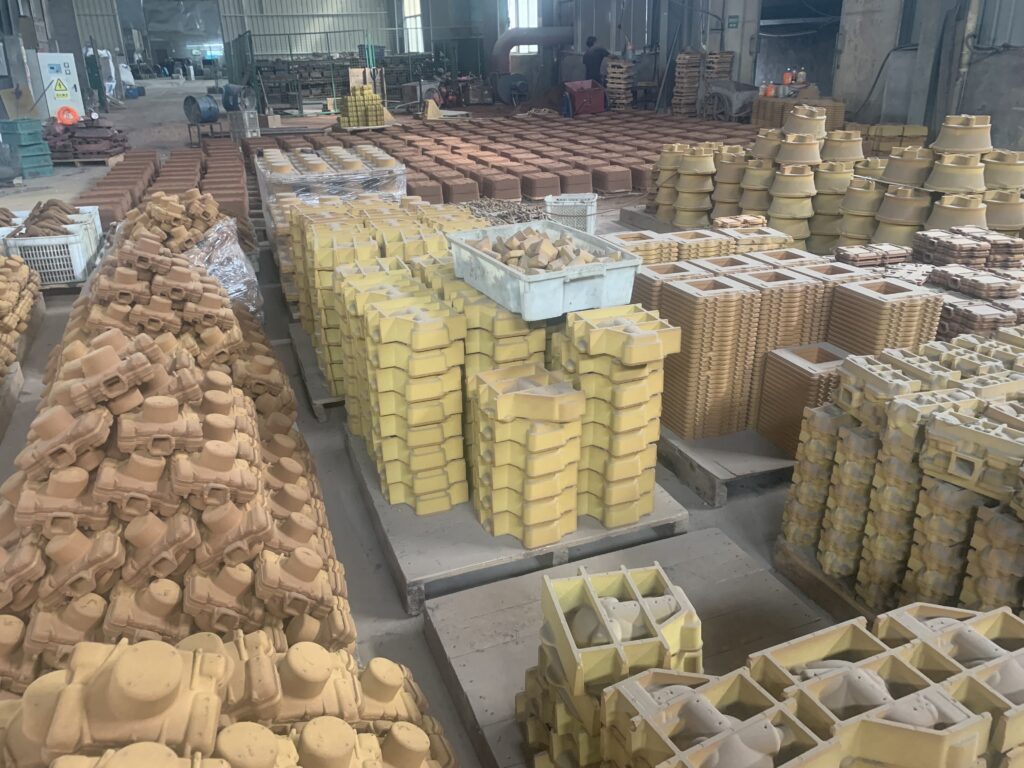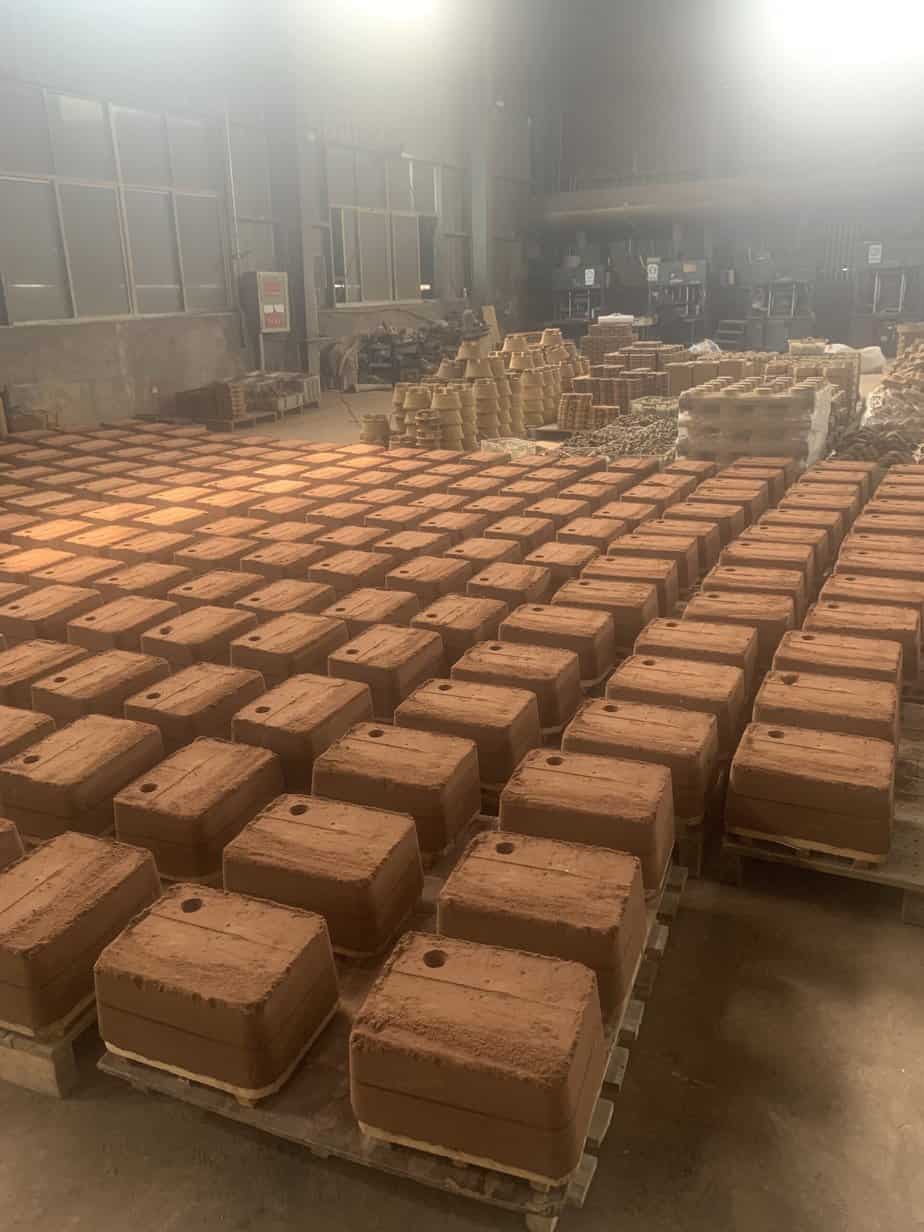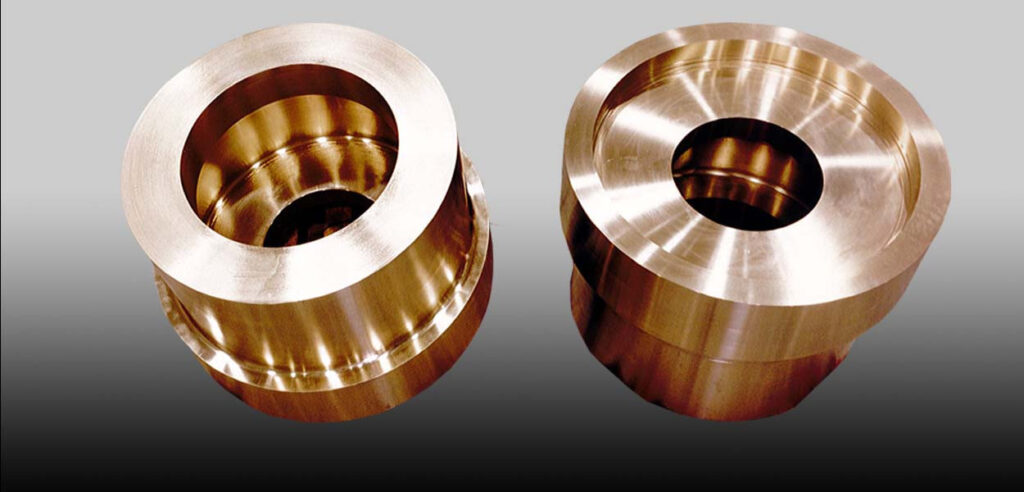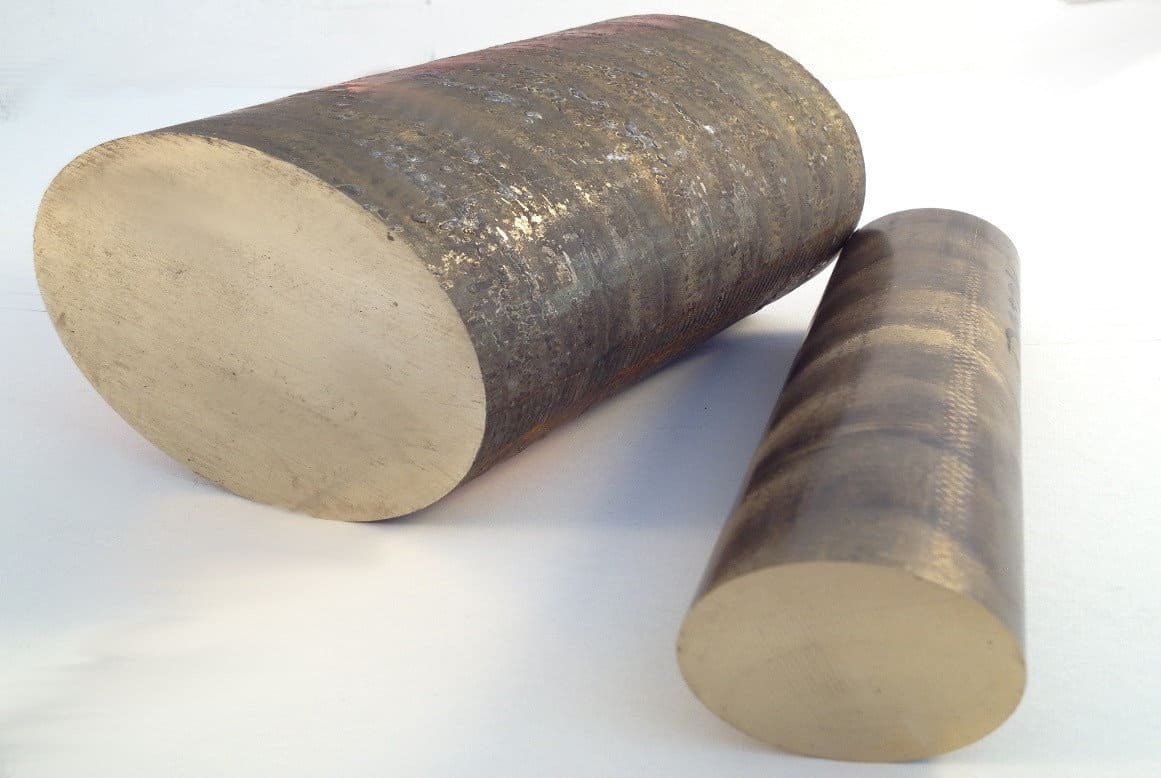Introduction:
Bronze is a mixture of both tin and copper. Although its composition varies, contemporary bronzes typically contain between 80 to 90% copper. Different types of bronze can be made by adding other elements. These include manganese, aluminum, nickel, phosphorus, silicon, arsenic, and zinc. Yet, all of these have their own set of appropriate qualities. Most bronzes are modified from the original alloy by adding one or more elements.
Physical Properties
| Density | 8800 kg m3 |
| Melting point | 880-1025°C |
| Electrical conductivity | 15% |
| Appearance/color | Reddish (mostly) |
| Yield strength | 450 MPa |
Grades of Bronze
Different bronze alloys are classified by their specific chemical makeup.
Alloy 954.
The aluminum bronze alloy has many applications, including industrial machinery and mounting.
Alloy 932.
This high-leaded tin bronze alloy creates non-pressure components, bushings, and washers.
Is Bronze Rust?
While bronze itself doesn’t rust, any exposed parts could eventually oxidize. Since copper is a constituent of bronze, it oxidizes in a series of steps when exposed to air. Yet, bronze is a material that exhibits a wide range of oxidation states. In addition, the bronze’s copper helps structure a green patina that prevents further corrosion. It will rust if bronze comes into touch with sulfurous mixtures or chlorine.
The Bronze Age
The Bronze Age was entitled because bronze was the most complex metal people used then. China and India both went through the Bronze Age at the same time. Even in the Bronze Age, a few things were used to make meteoritic iron. However, the way iron was refined was terrific. The Iron Age began around 1300 BC and came after the Bronze Age.
Properties of Bronze

Hardness.
Although bronze is a beautiful sculpting material, it is also one of the most complex copper alloys. Its tenacity is proportional to the proportion of its original material and the new element it contains. It can endure pressures ranging from 35,000 to 119,000 psi, though. Manganese bronze is the most severe form of bronze. Yet, it can withstand the maximum allowable pressure.
Melting point
Unlike other copper alloys, bronze is resistant to melting. Over 2000 degrees Fahrenheit of heat are required to melt bronze. This remarkable bronze property provides insight into our ancient forbears’ resourcefulness. Amazingly, they were able to produce such a large amount of heat. They used primitive techniques to create bronze and could repeat the process.
Corrosion resistance.
With corrosion-resistant constituents, it is not surprising that bronze is also resistant to corrosion. Some of its varieties, such as Muntz metal, can withstand saltwater. This is ten times more corrosive than tap water. Instead, it forms a protective coating known as patina. This is typical of copper alloys.
Metal Supermarkets
What are Bronze’s Applications?
Since the discovery of steel and other metals with more suitable construction applications, bronze usage has declined significantly. Metallurgists who have spent a lifetime investigating this metal’s endless potential have enabled bronze to become helpful in various other applications. Here are some of bronze’s most prevalent applications.
Art.
The most common application of bronze is in art, notably as a sculpting medium. It is the material of choice for metal artists because its remarkable feature allows it to expand as it cools slowly. Although heavy and dense, bronze is relatively easy to manipulate. It allows sculptors to carve to their hearts’ content.
Construction.
Although bronze has been replaced by steel in various construction-related applications, it still has a role in some. For instance, numerous bridge components, wheels in worm drives, and bridge turntables are fabricated from a specific bronze alloy. Modern safety tools such as hammers, mallets, and wrenches are also constructed from bronze. These tools were initially made of steel, but bronze was substituted due to the risk of fire or explosion posed by the sparks steel can produce.
Machine Design.
Numerous machine parts, including spur gears, bushings, bearings, and valve components, are built of bronze. Yet, even valve guides in aircraft engines are ideally fabricated from bronze. It is because of high electrical conductivity, thermal resistance, and low-friction properties. Very few metals possess low-friction properties, critical when parts slide against one another at high speeds.
Bronze Alloys
Nickel Silver.
Nickel silver is a kind of bronze, although its name does not contain the word. It is made from bronze, tin, and nickel. Moreover, despite its name, this bronze does not include silver. Silver refers only to the silvery hue of the metal, which is not characteristic of bronze. This enormous change in appearance is one of the primary reasons why identifying bronze products or items can be challenging. This is primarily because customers are used to perceiving bronze as a brown metal.
Aluminum Bronze
Aluminum bronzes are a class of copper-based alloys with chemical and mechanical properties unmatched by any other series. They consist of 5 to 12 percent aluminum. Manganese, nickel, silicon, and iron are also in aluminum bronzes. They have equivalent strength to low-alloy steels and excellent corrosion resistance, especially in seawater and similar environments, where they frequently surpass stainless steel sheets.
The aluminum in the alloys reacts with atmospheric oxygen to form a thin, corrosion-resistant alumina (aluminum oxide) layer, a barrier against corrosion for the copper-rich alloy. They are available in cast and wrought forms.
Aluminum Bronze Applications
For handling saltwater, acidic mine waters, non-oxidizing acids, and industrial process fluids, aluminum bronze alloys are utilized in marine hardware, shafts, and pump and valve components. They are also used in heavy-duty sleeve bearings and machine toolways. Castings of aluminum bronze have excellent corrosion resistance, high strength, tensile strength, and wear resistance. Yet, there is no requirement to mention their perfect casting and welding properties.

Common Aluminum Bronze Alloys
Here is the list of common aluminum bronze alloys;
C95800: Suited for marine applications with optimal resistance to marine water corrosion.
C95200: It is a highly malleable material with effective corrosion-resistant properties.
C95900: It offers compressive strength and higher hardness. Yet, it employs die inserts, seats, valve guides, draw dies, wear plates, gears, and forming rolls.
C95400 offers extraordinary strength, tensile strength, and high yield and is exceptionally resistant to deformation and wear.
Properties of aluminum bronze alloy C95400
| Mechanical Properties | Physical Properties |
| Tensile strength (min) – 85ksi | Density – 0.269 lb/in3 at 68°F |
| Yield strength (min) – 32ksi | Meeting point (liquids) – 1900°F |
| Brinell hardness (min) – 170 Bhn | Specific gravity – 7.5 |
Phosphor Bronze
Adding a minute amount of phosphorus can make bronze extremely durable. It can enhance the tensile strength and yield of bronze by a factor of several. Yet, it depends on how much is added to the combination. Only 0.01 to 0.35 percent phosphorous should be added to prevent the strength from becoming brittle. Phosphorus improves bronze’s durability, abrasion resistance, coefficient of friction, and hardness. Phosphor bronze is, therefore, ideally suited for applications involving the continual and fast sliding of metal surfaces.
Properties of Phosphor Bronze Alloys
Because of their excellent spring properties, higher strain resistance, great flexibility, and high corrosion resistance, phosphor bronze alloys are predominantly utilized for electrical equipment. The addition of tin enhances the alloy’s corrosion resistance and strength. The phosphor improves the alloy’s wear resistance and stiffness.
C544 Phosphor bronze is one of the best-bearing alloys available on the market. As a supplier of phosphor bronze, Aviva Metals offers several forms and sizes to fulfill the requirements of your project, including sheets, strips, plates, wires, rods, and bars.
Uses of Phosphor Bronze
Phosphor Bronze is typically employed to produce springs, fasteners, and bolts. These components must be highly durable and wear while maintaining high flexibility.
Automobiles, digital electronics, and automatic controllers often incorporate Phosphor Bronze components. The material is ideal for molding operations such as drawing, pressing, and bending. Phosphor Bronze components are recognized for their superior performance, ease of processing, and durability.
Composition:
| Tin | 4.2 – 5.8% |
| Copper | 93.4 – 95.32% |
| Iron | 0.10% (max) |
| Phosphorus | 0.030 – 0.35% |
| Lead | 0.05% (maximum) |
| Zinc | 0.30% (maximum) |
Cupronickel

Cupronickel is a bronze alloy containing between 2% to 30% nickel and is also known as copper-nickel. The alloy is thermally stable and corrosion-resistant, particularly in steam or humid air. It is also preferable to other types of bronze in seawater. Cupronickel is utilized for pumps, ship hulls, valves, electronics, and marine machinery, among other applications.
Bell Metal (High-Tin Bronze)

Traditionally, bell metals are copper-based alloys alloyed with tin, frequently containing more than 20% tin (typically, 78 percent copper, 22 percent tin by mass). Bell metal is the substance used to create bells of exceptional quality. The more the tin content, the more complex the metal and its resonance.
Increased tin concentration increases the decay duration of the bell strike, making the bell more resonant. In addition to gears, high-strength bushings, high-tin bronzes are utilized in gears, high-strength bushings, and applications requiring high strength and heavy loads.
Silicon Bronze.

Silicon is nearly the ideal alloying metal due to its ease of pouring, visually appealing surface properties, and high corrosion resistance. Additionally, silicon fits excellently into the bronze alloy. Even if only about 6 percent of the bronze alloy is composed of silicon, this gives bronze the self-lubricating properties required to be easily shaped or cast into intricate designs.
Uses of silicon bronze
Landing gear components, strut bushings, rock bit bearing bushings, valve guides, cams, pole line hardware, safety belt assemblies, valve and pump components, hooks, and forged machined components are popular applications for silicon aluminum bronze. Aerospace, oil and gas, automotive, electrical, and marine industries, among others, all utilize silicon aluminum bronze.
Manganese Bronze
Additionally, manganese can make bronze complex and robust. This enables bronze to handle high-load applications and low-speed, which were formerly among its few limitations. However, manganese’s muscular bearing strength makes bronze a non-heat-treatable metal, necessitating special lubricants in applications utilizing manganese bronze.
While each kind of bronze has a distinct set of attributes due to its additional element, they all have some characteristics. These characteristics define the diversity of bronze metal applications.

Manufacture method for bronze
- 1. Mining
Initially, most metals were gathered from rocks on the ground, in creek beds, and by prying prominent pieces from cliff faces. In their raw and natural state, copper and tin ore had to be mined from deeper within the earth as the demand for bronze soared.
Mine shafts were carved into hills around 4000 BCE in the Balkans, the earliest evidence of mining. We find evidence of onsite crucible smelting at copper mines in the Sinai Peninsula that dates back to 3800 BCE.
- 2. Smelting
The smelting process is required between the mining of raw ore and the casting of metal objects. Most metals do not exist in their purest form in their natural state. Other rock veins flow through it frequently, or the metal is embedded in other rocks as specks and flakes. A furnace is utilized to separate the d metal from the ore.
Copper requires temperatures of approximately 2000 degrees Fahrenheit in the furnace. At this temperature, copper melts and drips out of the surrounding rock. If the surrounding rock or other metals in the ore have a lower melting point than the ore, the ore will melt before the surrounding rock or metals. Bronze Age miners and metalworkers quickly discovered how to separate the various metals and their use, from jewelry to tools.
- 3. Pouring
After refining the copper, tin was added to create bronze. The bronze was then poured into sand molds and allowed to cool. This technique, called casting, was utilized to manufacture bronze swords, brooches, knives, and pins.
The bronze can be polished and fashioned into a variety of shapes. It might be melted down and transformed into something else. Due to its durability, it was beneficial for crafting peasant implements and warrior weapons. Three methods of casting exist:
- 3.1. Sand Casting:
Sand casting is the earliest of the three processes. This process involves constructing a pattern in the shape of the desired component. The design is, after that, placed in a flask containing sand. The pattern is removed after adding a binding agent to solidify the sand and curing the mold.
Pour molten bronze into the remaining hollow space to form the necessary shape. After the metal has cooled, the sand mold is removed, leaving only the sand casting. This casting can be sold in its current state or undergo extra finishing processes. One of the benefits of sand casting is the ability to create distinctive shapes that are impossible with traditional procedures.
- 3.2 Centrifugal Casting
Commonly, cylinder-shaped castings are produced using centrifugal casting. In centrifugal casting, a cylinder-shaped mold is employed. The mold is then rotated or spun around its axis at a preset speed. The wall thickness of casting is determined by the amount of material inserted during pouring. Due to the characteristics of centrifugal casting, the inner diameter of the item must always be round.
Most metal impurities are less dense than the metal itself. Throughout the casting process, these contaminants will concentrate in the inner diameter of the casting and can be eliminated. Consequently, the casting contains fewer impurities.
- 3.3 Permanent Casting
Bronze is cast in a continuous length using the continuous casting method. Pouring molten bronze into a mold gives it its shape. A cut-off determines the length of the casting saw, not the mold. In continuous casting, gravity is utilized to help move the metal along. This casting process begins high above the ground and requires much space.
Continuous casting has a lower material loss rate and a better production rate than other techniques. This approach results in generally superior casting quality. This is because of the reduced solidification time and more uniform material properties.